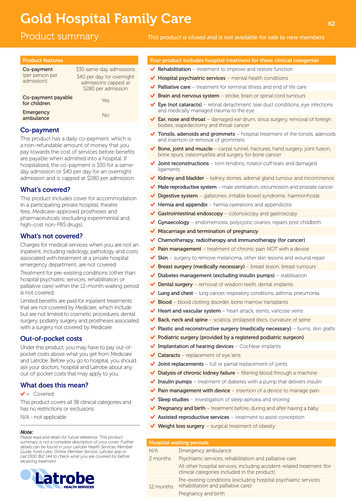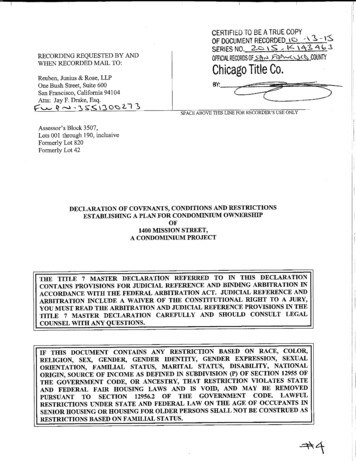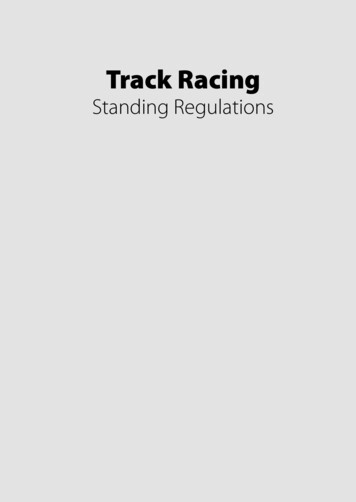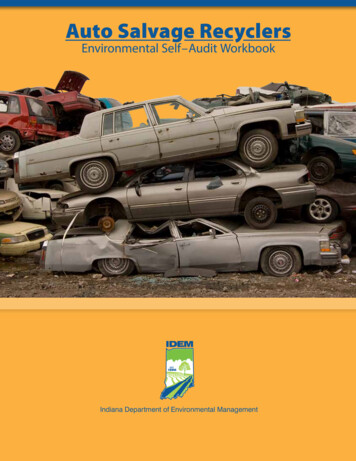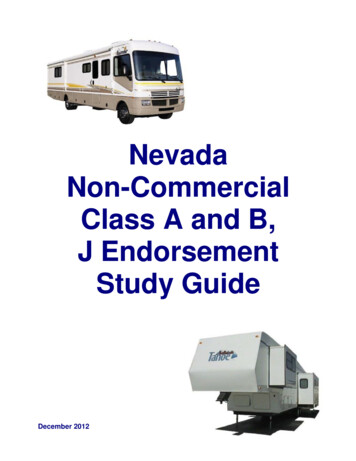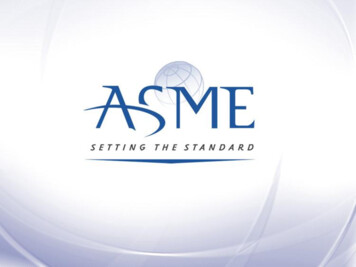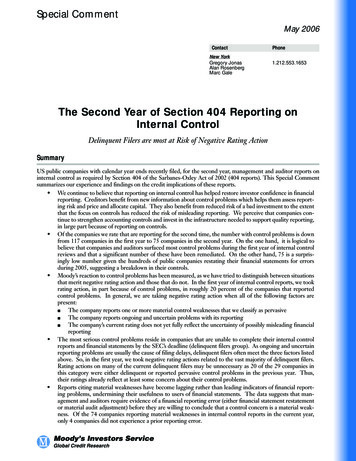
Transcription
Special CommentMay 2006ContactPhoneNew YorkGregory JonasAlan RosenbergMarc Gale1.212.553.1653The Second Year of Section 404 Reporting onInternal ControlDelinquent Filers are most at Risk of Negative Rating ActionSummaryUS public companies with calendar year ends recently filed, for the second year, management and auditor reports oninternal control as required by Section 404 of the Sarbanes-Oxley Act of 2002 (404 reports). This Special Commentsummarizes our experience and findings on the credit implications of these reports. We continue to believe that reporting on internal control has helped restore investor confidence in financialreporting. Creditors benefit from new information about control problems which helps them assess reporting risk and price and allocate capital. They also benefit from reduced risk of a bad investment to the extentthat the focus on controls has reduced the risk of misleading reporting. We perceive that companies continue to strengthen accounting controls and invest in the infrastructure needed to support quality reporting,in large part because of reporting on controls. Of the companies we rate that are reporting for the second time, the number with control problems is downfrom 117 companies in the first year to 75 companies in the second year. On the one hand, it is logical tobelieve that companies and auditors surfaced most control problems during the first year of internal controlreviews and that a significant number of these have been remediated. On the other hand, 75 is a surprisingly low number given the hundreds of public companies restating their financial statements for errorsduring 2005, suggesting a breakdown in their controls. Moody’s reaction to control problems has been measured, as we have tried to distinguish between situationsthat merit negative rating action and those that do not. In the first year of internal control reports, we tookrating action, in part because of control problems, in roughly 20 percent of the companies that reportedcontrol problems. In general, we are taking negative rating action when all of the following factors arepresent: The company reports one or more material control weaknesses that we classify as pervasive The company reports ongoing and uncertain problems with its reporting The company’s current rating does not yet fully reflect the uncertainty of possibly misleading financialreporting The most serious control problems reside in companies that are unable to complete their internal controlreports and financial statements by the SEC’s deadline (delinquent filers group). As ongoing and uncertainreporting problems are usually the cause of filing delays, delinquent filers often meet the three factors listedabove. So, in the first year, we took negative rating actions related to the vast majority of delinquent filers.Rating actions on many of the current delinquent filers may be unnecessary as 20 of the 29 companies inthis category were either delinquent or reported pervasive control problems in the previous year. Thus,their ratings already reflect at least some concern about their control problems. Reports citing material weaknesses have become lagging rather than leading indicators of financial reporting problems, undermining their usefulness to users of financial statements. The data suggests that management and auditors require evidence of a financial reporting error (either financial statement restatementor material audit adjustment) before they are willing to conclude that a control concern is a material weakness. Of the 74 companies reporting material weaknesses in internal control reports in the current year,only 4 companies did not experience a prior reporting error.
Internal control reports citing controls related to preventing and detecting fraud remain rare. In the current year only four companies referred to tone at the top or other fraud-related controls and in each casethe companies had discovered instances of fraudulent reporting or aggressive accounting prior to reportingfraud-related control problems. Waiting for fraud to occur before auditors identify and flag weak tone atthe top of a company obviously undermines the ability of control reviews to prevent fraudulent reporting.It would help creditors were management, audit committees and auditors to devote more attention to controls that prevent and detect fraudulent reporting, and to not wait for disasters to occur before flagging control problems.If increased scrutiny of controls is effective, then we can expect in 2006 a dramatic reduction in the number ofcompanies restating their financial statements for errors and fraudulent reporting. That reduction would suggest thatthe investments in reporting infrastructure have surfaced the problems of the past, and creditors can enjoy the benefitsof quality reporting on which the market depends. Conversely, continuing high levels of restatements would call intoquestion the substance of regulation, control reporting and auditing.Companies Reporting Material WeaknessesAppendix 1 lists the companies we rate that have been delinquent filers or have reported material weaknesses in controls in the current year. Most of the companies on this list are calendar year-end filers, and are filing 404 reports forthe second time. Many non-calendar year-end filers have filed only once thus far, but will do so again in the next fewmonths.Overall, there are 107 companies in Appendix 1, representing about 3 percent of the US companies we rate. Thiscompares favorably to the 7 percent of all eligible US companies that have reported material weaknesses. Moody’srates companies that are, on average, larger than the typical public company. We suspect that larger companies maintain more sophisticated control systems and are less likely to suffer control problems.To see the trend in the number of companies reporting control weaknesses, we need to consider only those companies that have reported for the second time (second time filers). Of the second time filers we rate, the number withmaterial weaknesses is down from 117 companies in the first year to 75 companies in the second year. On the onehand, it’s logical to believe that companies and auditors surfaced most control problems during the first year of internalcontrol reviews and that a significant number of these have been remediated. On the other hand, 75 is a surprisinglylow number given the hundreds of public companies restating their financial statements for errors during 2005. Thereare legitimate reasons why a company that restates for errors during a year can avoid reporting a material controlweakness. For example, the company could have remediated the control problem by year-end, the point in time whenmanagement and auditors measure control effectiveness. However, the significant shortfall could also indicate thatauditors are being lenient in flagging control problems.Similar to last year’s result, the companies reporting control problems are a diverse group, varying widely in industry, size and rating level. The 107 companies in Appendix 1 are dispersed across 68 specific industries and with littleconcentration in any one sector. Revenues vary widely ranging from 10 million to over 190 billion. Average revenue is about 7 billion while median revenue is only about 1.5 billion. Rating levels range from Aaa to C. However,the average rating for the group with control problems was B1, which is 4 notches below the average for all US companies we rate (Baa3).Nature of Control WeaknessesMoody’s classifies material weaknesses in internal control as either Category A or B1: Category A: Weaknesses that relate to controls over specific account balances or transaction-level processes.In most cases, we believe that the auditor can effectively “audit around” these material weaknesses by performing additional substantive procedures in the area where the weakness exists. We typically give companies reporting Category A material weaknesses the benefit of the doubt and do not take any related ratingaction based solely on the fact of the reported weakness, assuming management takes corrective action toaddress it in a timely manner. Category B: Weaknesses that relate to company-level controls, such as an ineffective control environment,weak overall financial reporting processes, or ineffective personnel. We question the ability of the auditorto effectively “audit around” a Category B material weakness. In these cases, we generally bring a company1.2See our Special Comment, Section 404 Reports on Internal Control: Impact on Ratings Will Depend on Nature of Material Weakness Reported, dated October 2004.Moody’s Special Comment
to rating committee to determine whether a rating action is needed. Category B weaknesses also includethose companies that report several Category A weaknesses and those companies that have reported material control weaknesses for the second year running.The following table summarizes companies we rate with material control weaknesses:Delinquent filersCategory B weaknessesCategory A weaknessesCompanies that have only reported for oneyear under 404Total companies reporting in the current year(Appendix 1)Current YearPrior Year29301621385832107Appendix 2 summarizes the nature of control weaknesses for each of the companies reporting control problems.Appendix 3 organizes this same data by type of weakness.Delinquent filersAlthough we track them in a separate category, delinquent filers demonstrate Category B control weaknesses. Webelieve that the inability to complete financial reporting on a timely basis is itself a company-level control weaknessthat generally merits rating committee consideration. Further, many delinquent filers disclose material weaknesses inadvance of ultimately filing their financial statements that fall into the Category B group.Surprisingly, the number of delinquent filers is up in the current year. The reason is that delinquent filers tend toexperience control problems that persist. Of the 21 companies that were delinquent in the first year of 404 reporting,11 remained delinquent in the second year.Category B weaknessesThe most common types of Category B weaknesses relate to ineffective accounting personnel in company-wide functions and pervasive ineffective processes2. Together, these two areas account for about 80 percent of the Category Bweaknesses that companies reported (excluding delinquent filers).Insufficient accounting skills and pervasive ineffective processes reflect an underinvestment in the infrastructureneeded for quality reporting. In an effort to improve efficiency or take advantage of technology, some companies haveapparently under-staffed their accounting functions in recent years. For complex or non-routine areas, they relied ontheir auditors for help, rather than building in-house competence. Section 404 reports are bringing attention to thisproblem, which has inspired companies to reinvest in the accounting functions.Category A weaknessesThe most common types of Category A weaknesses relate to income taxes, accounts payable and accrued liabilities,revenues and related receivables, inventory, derivative instruments, leasing, and cash flow presentation. Takentogether, these 7 areas represent over 80 percent of all Category A weaknesses, with the remainder spread across 12other areas.Problems with accounting for income taxes alone represented about a third of all Category A weaknesses. Thetopic is often complex, and some companies have traditionally relied on their auditors to advise and assist companypersonnel. However, recent regulations have discouraged auditor reliance, and some companies are struggling tobuild in-house competence.Other frequent Category A weaknesses generally involve complex areas or areas involving estimates, judgmentsand non-routine transactions or events, increasing the risk of error. In contrast, leasing and cash flow statement issuesmostly involved long-standing requirements that the SEC brought attention to that a number of companies and auditors had simply overlooked.For second-year filers, the number of companies with Category A weaknesses declined significantly compared tothe prior year. Part of the decline is due to 10 companies whose Category A weaknesses in the second year we deem tobe Category B because these companies also reported control problems in the first year (repeat offenders). Part of thedecline also reflects successful remediation of control problems by companies reporting Category A weaknesses in thefirst year of 404, as discussed further below. The rest of the decline could reflect a general improvement in processspecific controls that has occurred because of increased scrutiny in recent years. Or, it could be that management and2.Two examples of these processes include ineffective quarterly book-closing process, and ineffective management monitoring of general accounting functions.Moody’s Special Comment3
auditors are reluctant to classify as material weaknesses control problems that they did not flag in the previous year.The number of companies restating for errors in 2006 will help inform us whether control problems are really declining.Impact of Control Weaknesses on Moody’s RatingsMoody’s reaction to control problems has been measured, as we have tried to distinguish between situations that meritnegative rating action from those that do not. In the first year of internal control reports, we took rating action, in partbecause of control problems, in about 20 percent of the companies that reported control problems.In general, despite material weaknesses, we are finding that rating actions are not needed in many cases because: Control problems appear to be specific, localized and correctable within a short period (Category A weaknesses) The rating already reflects our impression of the control weaknessIn general, we are taking negative rating action when all of the following factors are present: The company reports one or more material control weaknesses that we classify as pervasive (Category B) The company reports ongoing and uncertain problems with its reporting, such as delinquent filings, recurring restatements for errors, instances of aggressive accounting, ongoing internal or external investigationsinto the company’s reporting, or ineffective remediation of lingering control problems The company’s current rating does not yet reflect the uncertainty of possibly misleading financial reporting.The most serious control problems reside in companies that are unable to complete their internal control reportsand financial statements by the SEC’s deadline (delinquent filers group). As ongoing and uncertain reporting problems are usually the cause of filing delays, delinquent filers often meet the three factors listed above. Further, delinquent filers often face loan covenant violations and lose access to the capital markets. As a result, in the first year, wetook negative rating actions related to the vast majority of delinquent filers.As listed in Appendix 1, in the current year, 33 companies were delinquent filers, 29 of which are second year filers. Delinquent status is not new news for 11 of the 29 companies, which were also delinquent in the prior year.Another 9 of the 29 delinquent filers reported pervasive material weaknesses in the prior year. So, for at least 20 of the29 companies, our ratings already reflect at least some uncertainly resulting from pervasive control problems.Appendix 5 lists 29 companies on which we took negative rating action in part because of concerns about weakaccounting controls, during the period from April 2005 to April 2006. The Appendix quotes from the part of ourresearch that refers to accounting controls. Our rating actions have ranged from a lower rating outlook to multi-notchdowngrades. Consistent with our policy, we are convening rating committees to discuss any company that reports aCategory B weakness, including delinquent filers. Additional rating actions are possible.In most cases, the control problems cited in internal control reports do not impact the company’s credit risk.However, creditors should be alert to delinquent filers and companies that report pervasive control problems coupledwith ongoing and uncertain reporting problems, suggesting heightened risk for creditors.Remediation of Control ProblemsAppendix 4 indicates companies’ relative success in remediating the control problems they reported in the first year ofinternal control reporting.Delinquent filers have been largely unsuccessful in remediating problems. Of the companies that were delinquentin the first year of 404 reporting, 86 percent either remained delinquent or continued to report material control weaknesses in the second year. Of the 21 companies on the list, 11 are still delinquent. Only 3 companies cured both theirdelinquency and their control problems.Why are delinquent company’s control problems so persistent? The reason is that the problems causing the delinquency are severe and take time to resolve. Many of the companies didn’t employ enough people with the right skillsor have inadequate systems that can’t produce reliable numbers. Many faced internal and external investigations thatrequire huge amounts of time and are distracting.Companies reporting Category B weaknesses in the first year have been moderately successful in remediating control problems. Of the 38 companies listed, 23 companies, or about 60 percent, reported no material weaknesses in thesecond year. However, the control problems of 9 of the 38 companies worsened in the second year as they becamedelinquent filers. The remaining 6 companies, although not delinquent, reported continuing control problems in the4Moody’s Special Comment
second year. Thus, for a substantial minority of companies, the pervasive nature of Category B control weaknesses hasproven difficult to remediate.The good news is that companies reporting Category A weaknesses have been mostly successful in remediatingtheir control problems. Of the 58 companies listed, 49 companies, or 84 percent, successfully remediated their controlproblems and reported no material weaknesses in the second year. We suspect that remediating Category A weaknesses is easier because of the specific and narrowly focused nature of these weaknesses.Information Content in Internal Control ReportsWe had hoped that the material weaknesses cited in internal control reports would provide insight into the risk offuture errors in financial reporting, and provide management time to address control issues before they resulted inreporting failures. Unfortunately, this is not the case, as reports citing material weaknesses currently appear to be lagging rather than leading indicators of financial reporting problems, undermining their usefulness to users of financialstatements.The data suggests that management and auditors require evidence of a financial reporting problem (restatementfor error or material audit adjustment) before they are willing to conclude that a control concern is a material weakness. That is, it appears that management and auditors are inferring the existence of control problems from financialreporting errors. Of the 74 companies reporting material weaknesses in internal control reports in the current year,only 4 did not experience a prior reporting problem3.Why are management and auditors so reluctant to cite a material weakness absent evidence of a past error? Concluding that a control issue is a material weakness involves considerable judgment, which is sure to be questioned whenit involves controversial and unhappy news. We suspect that management, audit committees and auditors are askingfor hard evidence to support a view that control problems are material weaknesses. We also suspect that the hardestevidence available is when control breakdowns result in reporting errors.Unfortunately, requiring proof of control problems results in reporting the fewest possible problems and disclosing them after accounting errors have occurred. We can only hope that underneath the radar screen of public reporting is genuine improvement in controls that will prevent future errors from occurring. Creditors would benefit wereparties to the reporting process to adopt policies that result in more forward-looking disclosures about control weaknesses.Despite the lagging nature of material weaknesses, there is sometimes new news and incremental value in internalcontrol reports. This is particularly so for companies that cited control problems because of material audit adjustments surfaced in the audit process. Of the 74 companies reporting material weaknesses in internal control reports inthe current year, 38 referred to audit adjustments. Users don’t need internal control reports to learn about restatements of financial statements. However, absent internal control reports, users would not have known about the significant audit adjustments and the related control problems.Internal control reports citing controls related to preventing and detecting fraud remain rare. In the current yearonly four companies referred to fraud-related controls (including tone at the top) and in each case the companies haddiscovered instances of fraudulent reporting prior to reporting fraud-related control problems. Is it logical to believethat so few companies have weaknesses in fraud prevention and detection controls? Waiting for fraud to occur beforeauditors identify and flag weak tone at the top of a company obviously undermines the ability of control reviews to prevent fraudulent reporting. The data question whether management and auditors are sufficiently focused on controlsover fraudulent reporting, the driving force behind Sarbanes-Oxley legislation and internal control reporting.Creditors would benefit were management, audit committees and auditors to devote more attention to controlsthat prevent and detect fraudulent reporting, and to not wait for disasters to occur before flagging these critical controlproblems.3.The third column of Appendix 1 indicates for each company whether their reporting on controls referred to a restatement for errors or to audit adjustments.Moody’s Special Comment5
Related ResearchSpecial Comments:Section 404 Reports on Internal Control: Impact on Ratings Will Depend on Nature of Material WeaknessesReported, October 2004 (89482)Credit Implications for Companies that Fail to File Internal Control Reports on Time, March 2005 (91799)Section 404 Reporting on Internal Control: Our Early Experience, April 2005 (92048)To access any of these reports, click on the entry above. Note that these references are current as of the date of publication of this reportand that more recent reports may be available. All research may not be available to all clients.6Moody’s Special Comment
Appendix 1Characteristics of Companies Reporting Control Weaknessesin the Current Year1 As of April 1, 2006SeverityAccompanyingReporting Problem2?AES Corporation5B3RestatementIndependent PowerHolding CompanyBally Technologies Inc. 5BRestatement, AdjustmentCasinosBally Total Fitness Holding CorporationBDelinquentAmusements 1,095Bausch & Lomb IncorporatedBRestatement, AdjustmentDrugs/Cosmetics 2,232BearingPoint, Inc.BRestatement, AdjustmentMiscellaneous 3,376Bowne & Company, Inc. 5BDelinquentManagement Services 899Carmike Cinemas, Inc.BRestatement, AdjustmentMotion Pictures 495Cray, Inc. 4BDelinquentComputers/PeripheralsDana Corp. 5BRestatement, AdjustmentAutomotive Parts 8,990Delphi CorporationBDelinquentAutomotive Parts 28,622Doral Financial CorporationBDelinquentUS Bank Holding CompanyFannie Mae (Federal NationalMortgage Association)BRestatement, AdjustmentSovereign RelatedFinancial Co.Dresser, Inc.BDelinquentOil 1,992Ferro Corporation5BDelinquentChemicals 1,844First Bancorp PRBDelinquentUS Bank Holding CompanyFlowserve CorporationBRestatement, AdjustmentMechanical ComponentsHealthtronics, Inc. 5BDelinquentHealthcare Services/EquipmentHertz Corporation4BDelinquentAutomotiveHighwoods Properties, Inc.BRestatement, AdjustmentREIT 465Kansas City Southern5BDelinquentRailroads 640Navistar FinancialBDelinquentFinance - CaptiveNortel Networks Corporation 5BDelinquentTelecomm Equipment 9,828PHH Corp.BDelinquentMortgage Finance 2,973Pride InternationalBRestatementOil Service 1,712Reynolds and Reynolds CompanyBRestatementAutomotivesSaks, Inc. 4BRestatement, AdjustmentRetail-Department Stores 6,437Sea Containers Ltd.BRestatement, AdjustmentTransportationEquipment Leasing 1,742Sirva, Inc.BRestatement, AdjustmentTrucking 3,470Telephone and Data SystemsBRestatementTelecommunications 2,301Terex CorporationBDelinquentIndustrial Machinery 5,020Thermadyne Holdings CorporationBDelinquentIndustrial Machinery 483United States Cellular CorporationBRestatementTelecommunications 2,301Vesta Insurance GroupBDelinquentInsurance Holding CompanyCompanyIndustryDelinquent Filers:Revenue(MM)Most RecentYear Available 9,486 484 149 571 53,768Moody’s Special Comment 676 2,638 193 6,676 239 982 6187
Appendix 1Characteristics of Companies Reporting Control Weaknessesin the Current Year1 As of April 1, 2006CompanyCompanies Reporting MaterialWeaknesses in Section 404 Reports:SeverityAccompanyingReporting Problem2?IndustryAgilent Technologies, Inc.ARestatementElectronics Components 5,139AirTran Holdings, Inc.BAdjustmentAirlines 1,451Alpharma, Inc.BAdjustmentPharmaceuticalsAmerican International Group, Inc.BRestatement, AdjustmentInsurance: Property and CasualtyAmericredit Corp.ARestatementFinance – Non Captive 1,451Ameritrade Corp.ARestatementFinance – Non Captive 1,003Aspen TechnologyBAdjustmentComputers/PeripheralsBlyth, Inc. 4ANoConsumer Products 1,586Central Parking Corp.BAdjustmentMiscellaneous 1,134Central Vermont Public ServiceBNoIntegrated Electric UtilityCeridian CorporationBAdjustmentITChattem Inc.AAdjustmentConsumer ProductsChesapeake Corp.BRestatementForest Products/Paper 1,042CKE Restaurants, Inc. 4ARestatementRestaurants / Fast Foods 1,520CNA Financial Corp.BRestatementRetail-Specialty StoresConagra Foods Inc.ARestatementFood/Soft DrinksConstar CSK Auto Corporation5BRestatement, AdjustmentRetail- Specialty Stores 1,578Danka Business Systems PLCBAdjustmentElectrical Equipment 1,233Dollar General CorporationARestatementRetail-Discount Variety 7,661Dura AutomotiveAAdjustmentAutomotive Parts 2,344Dynegy IncorporatedBRestatement, AdjustmentIndependent PowerEastman Kodak CompanyBAdjustmentPhoto/OpticalEpicor SoftwareBRestatementSoftwareExide TechnologiesBAdjustmentAutomotive PartsGCI, Inc.AAdjustmentTelecommunicationsGeneral Growth PropertiesBOtherREITGeneral Motors CorporationBRestatement, AdjustmentAutomotiveGeneral Motors Acceptance CorporationARestatementFinance - CaptiveGenesco, Inc. 4ARestatementApparel 1,113H&R Block, Inc.AAdjustmentDiversified Financial Services 4,420Ikon Office Solutions Inc.ARestatementIndustrial - Diversified 4,377Ingles Markets Inc.BAdjustmentRetail Grocery Chain 2,274Integrated Alarm Services Group, Inc.BAdjustmentConsumer/Electronics 99Interpool Inc.BAdjustmentFinance-Non-Captive 417Interpublic Group of Companies, Inc.BRestatement, AdjustmentAdvertising 6,274Jo-Ann Stores, Inc. 4ARestatementTextiles 1,812Kellwood Co. 4ARestatementApparelKroger, Co. 4ARestatementRetail-Grocery ChainLeap WirelessBRestatement, AdjustmentTelecommunicationsLennox InternationalARestatementAppliances/UtensilsLoews Corp.ARestatementTobaccoLongview Fibre Co.BAdjustmentREIT 1,796Magellan Health ServicesARestatementHospitals/Nursing 1,808Markwest Energy PartnersBNoEnergy Services 499Movie Gallery Inc.BAdjustmentRetail – Speciality Stores 692MTR Gaming GroupAAdjustmentCasinos 358Navarre CorporationBRestatementElectronics Distribution 597NDCHealth Corp.BAdjustmentHealthcare Services/EquipmentOdyssey Re HoldingsARestatement, AdjustmentInsurance Holding Company8Moody’s Special CommentRevenue(MM)2005 554 108,905 270 311 1,459 279 9,872 14,567 975 2,313 14,268 289 81 443 3,073 192,604 19,207 2,062 56,434 915 3,366 16,018 388 2,576
Appendix 1Characteristics of Companies Reporting Control Weaknessesin the Current Year1 As of April 1, 2006CompanySeverityAccompanyingReporting Problem2?IndustryRevenue(MM)OM Group, Inc.BRestatement, AdjustmentChemicalsOneok, Inc.AAdjustmentGas DistributionPantry Inc.BRestatementRetail-Convenience StoresPaxson Communications l - Miscellaneous 1,477Petsmart, Inc. 5ARestatementRetail-Specialty Stores 3,364Polo Ralph Lauren CorporationAAdjustmentConsumer Products 3,061Pope and Talbot, Inc.BAdjustmentForest Products/PaperPopular Inc.ARestatementUS Bank Holding CompanyProgressive Gaming InternationalARestatementCasinosRadiologix, Inc.BRestatementHealthcare ServicesResidential Capital CorporationARestatementMortgage Finance 4,235Ryerson Inc.BRestatement, AdjustmentSteel 3,302SFBC InternationalBAdjustmentResearch/Development 430South Financial GroupAOtherUS Bank Holding Company 754Stewart Enterprises Inc.BRestatementFuneral Services 495Stillwater MiningBAdjustmentMetals/MiningSun MicrosystemsAAdjustmentComputer/ PeripheralsSusquehanna BancsharesARestatementUS Bank Holding Company 387SVB Financial GroupBRestatementUS Bank Holding Company 317TRM CorporationBAdjustmentVending MachinesUnited Rentals North America, Inc.BRestatement, AdjustmentIndustrial ConstructionVisteon CorporationBRestatement, AdjustmentAutomotive PartsWynn Resorts LTDANoHotels 1,250 12,676 4,429 254 849 2,666 78 251 508 11,070 125 3,094 16,976 7221 Fiscal years ending 1/16/05 - 1/15/062 Restatement Restatement of previously filed financial statements, Adjustment Financial statement adjustments proposed by management/auditorprior to release of financial statements, Other Other issue accompanying the control problem, Delinquent Specific accompanying problems are likely3 Material weakness with pervasive impacts, comp
internal control as required by Section 404 of the Sarbanes-Oxley Act of 2002 (404 reports). This Special Comment summarizes our experience and findings on the credit implications of these reports. We continue to believe that reporting on internal cont rol has helped restore investor confidence in financial reporting.




